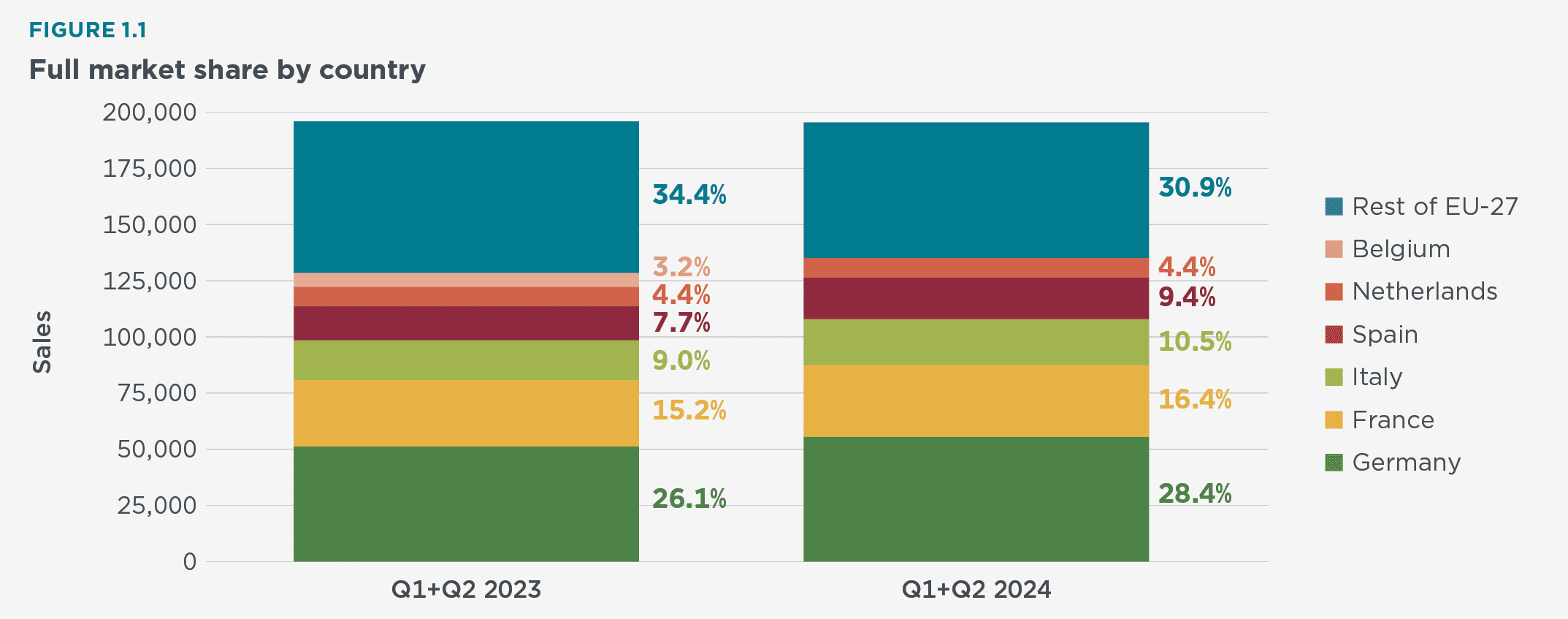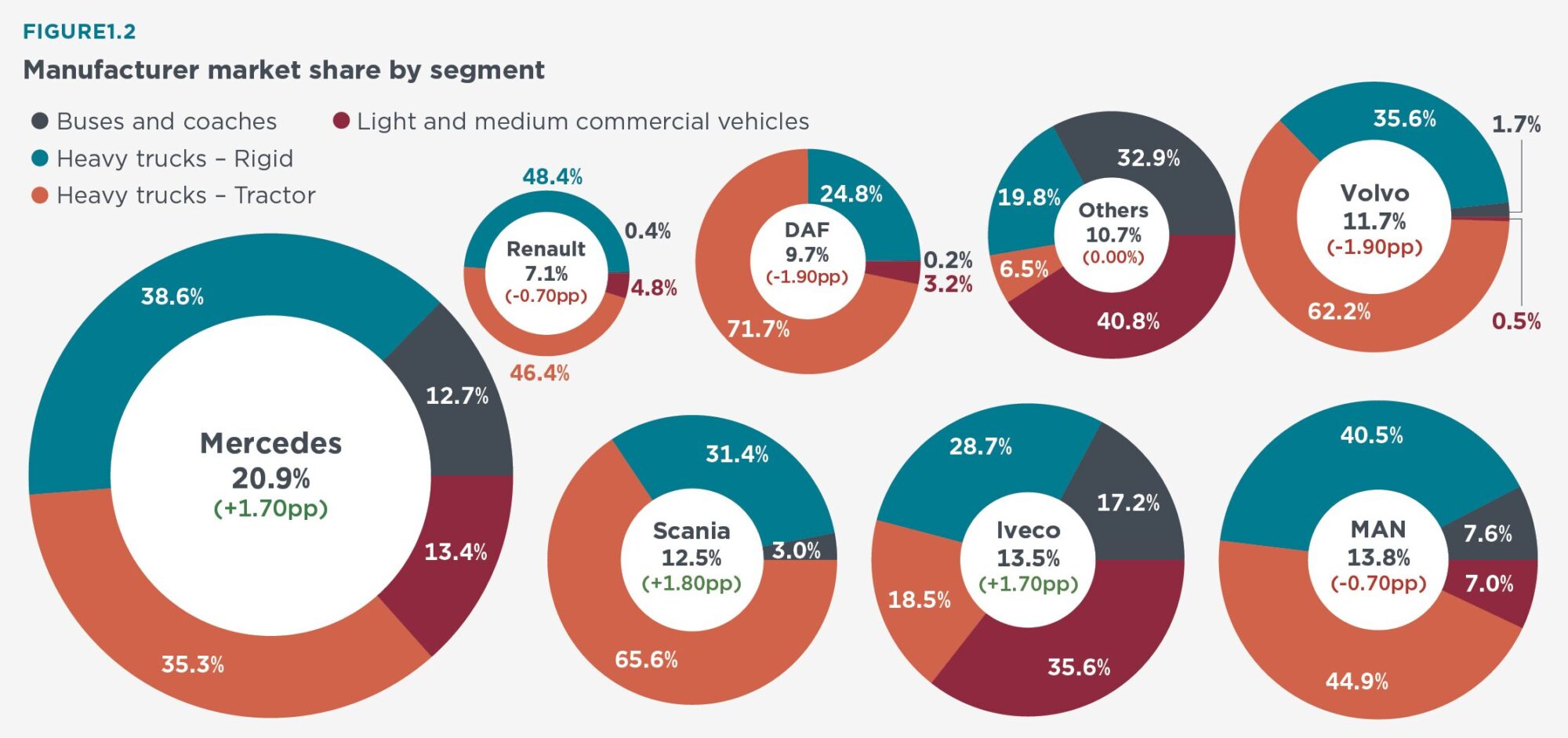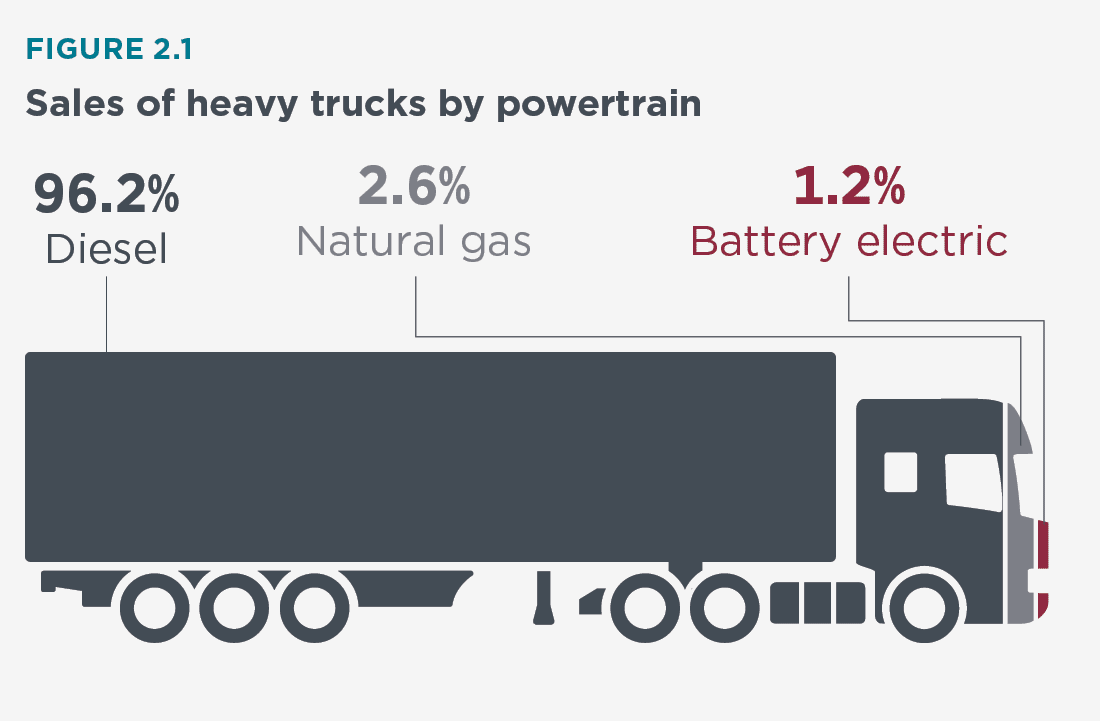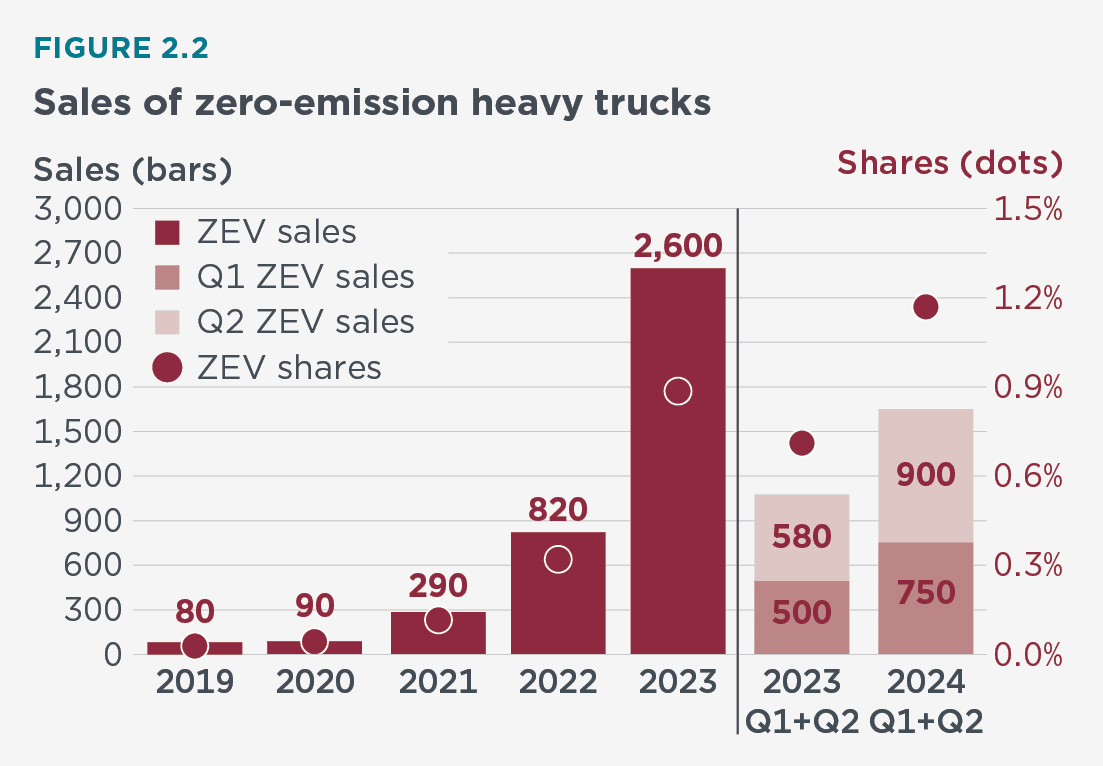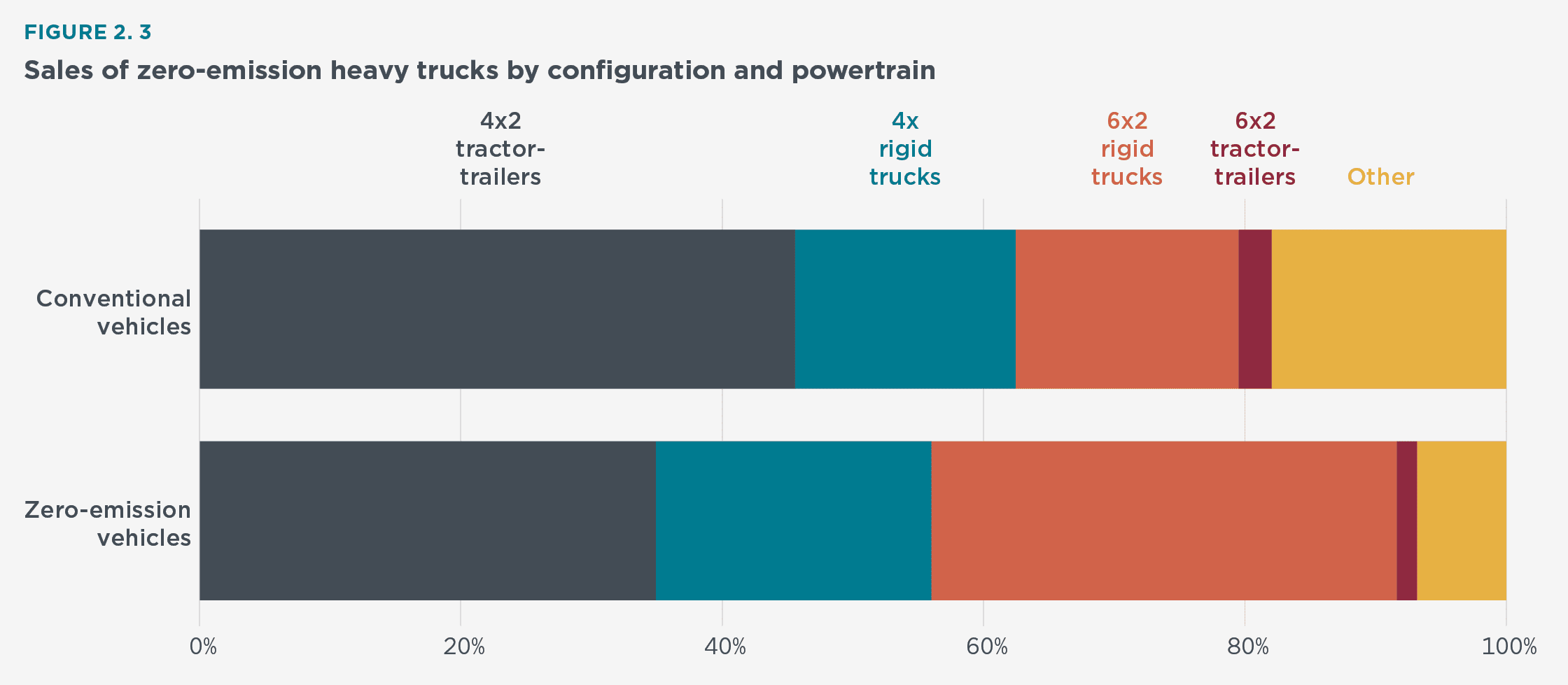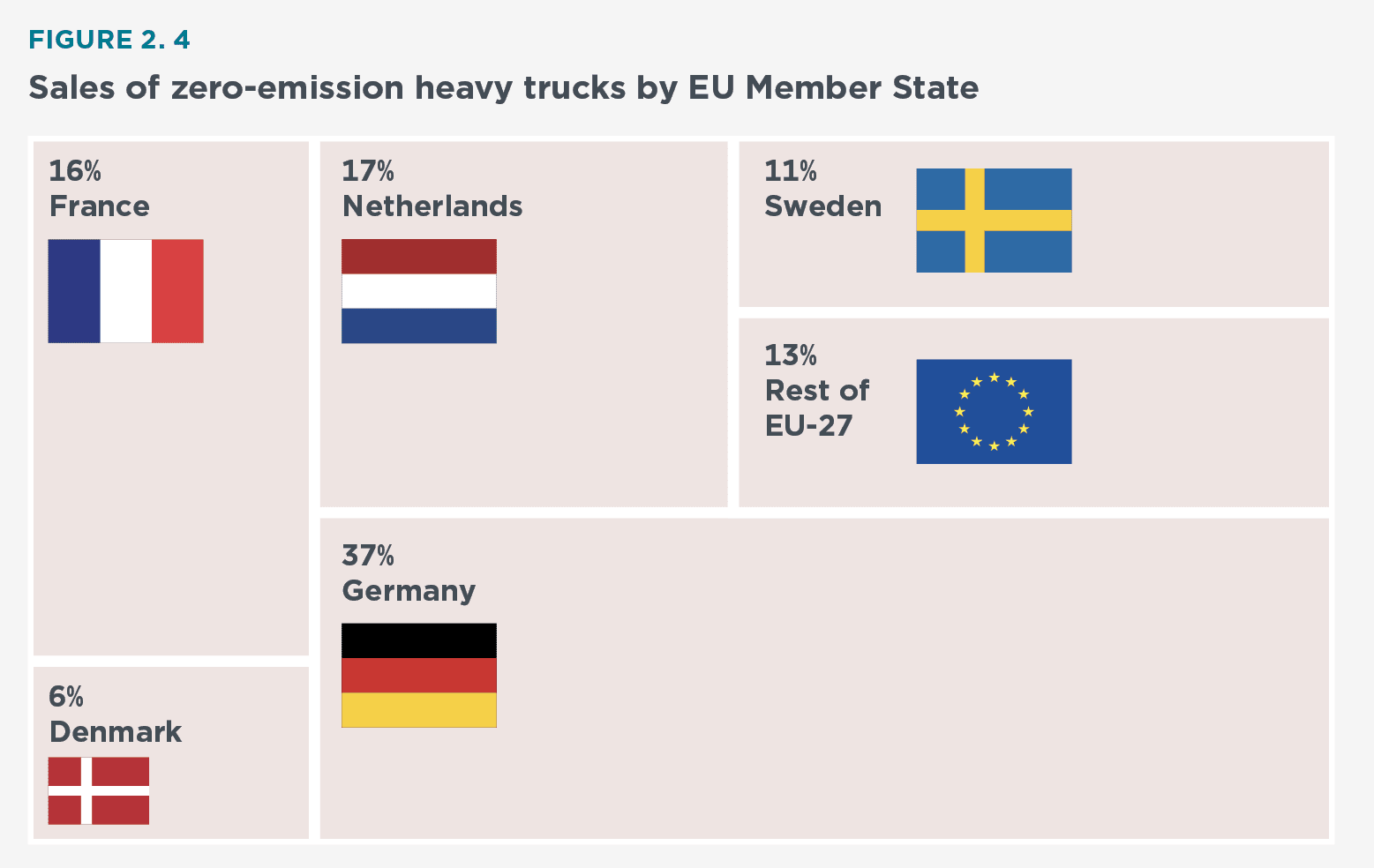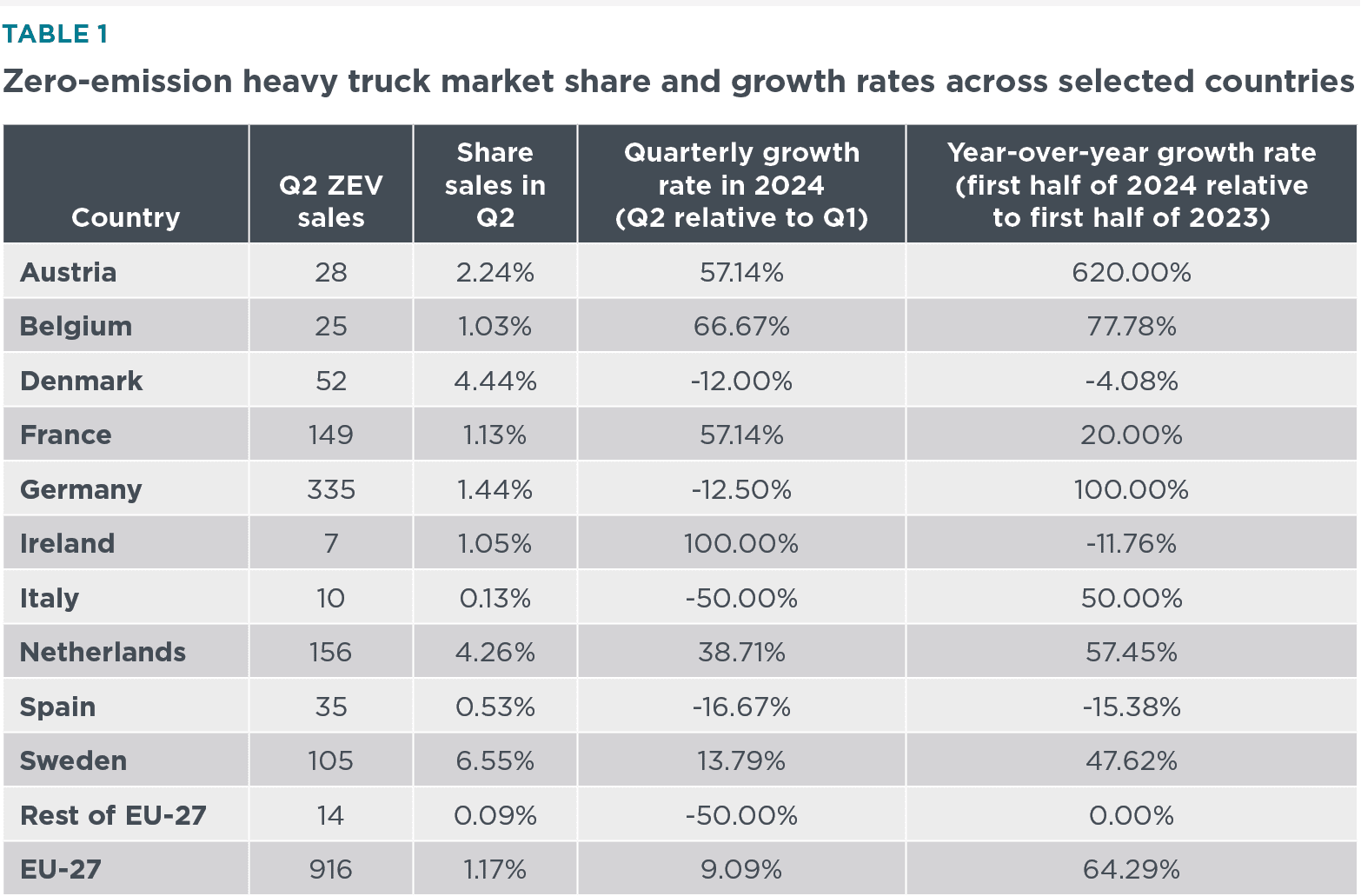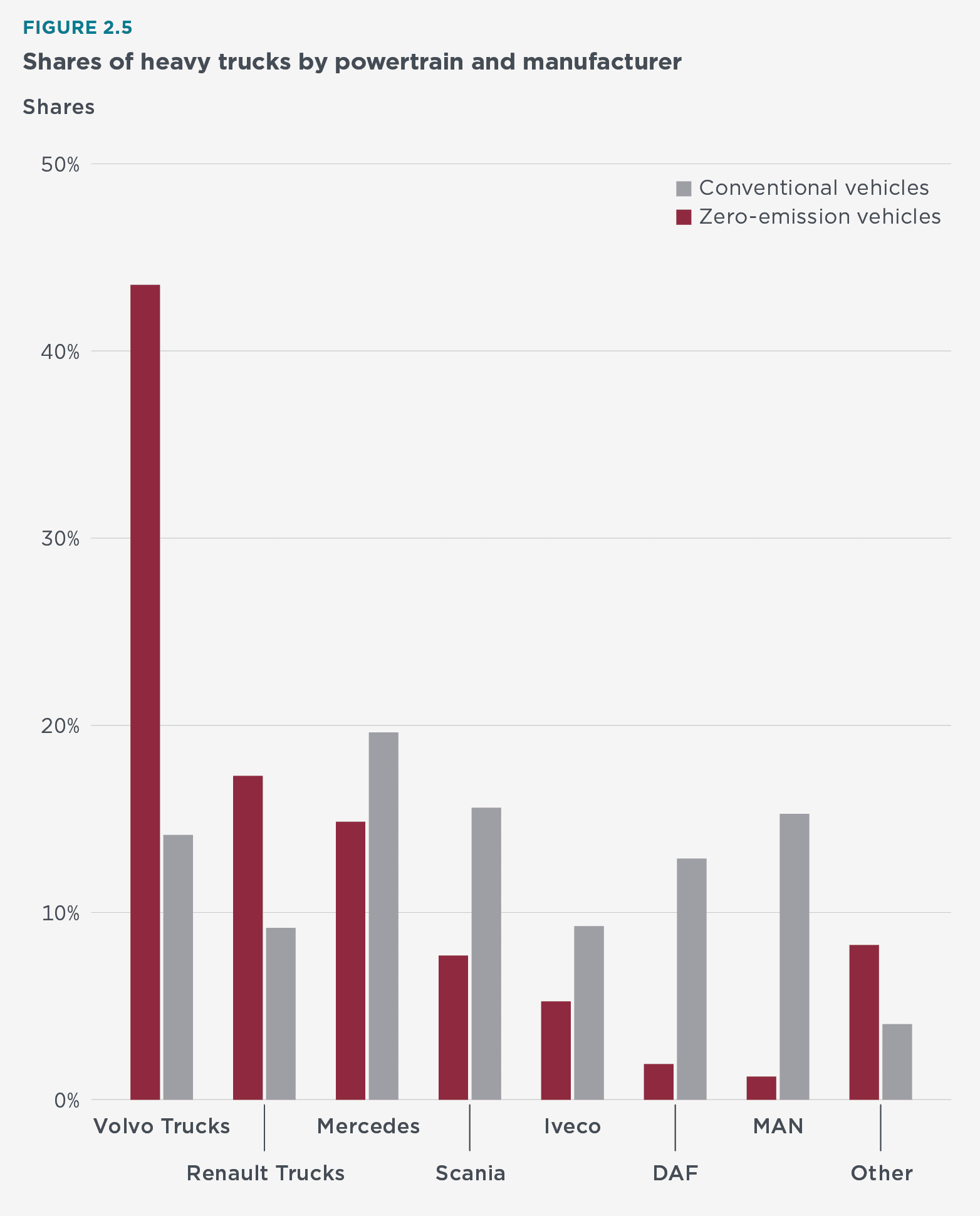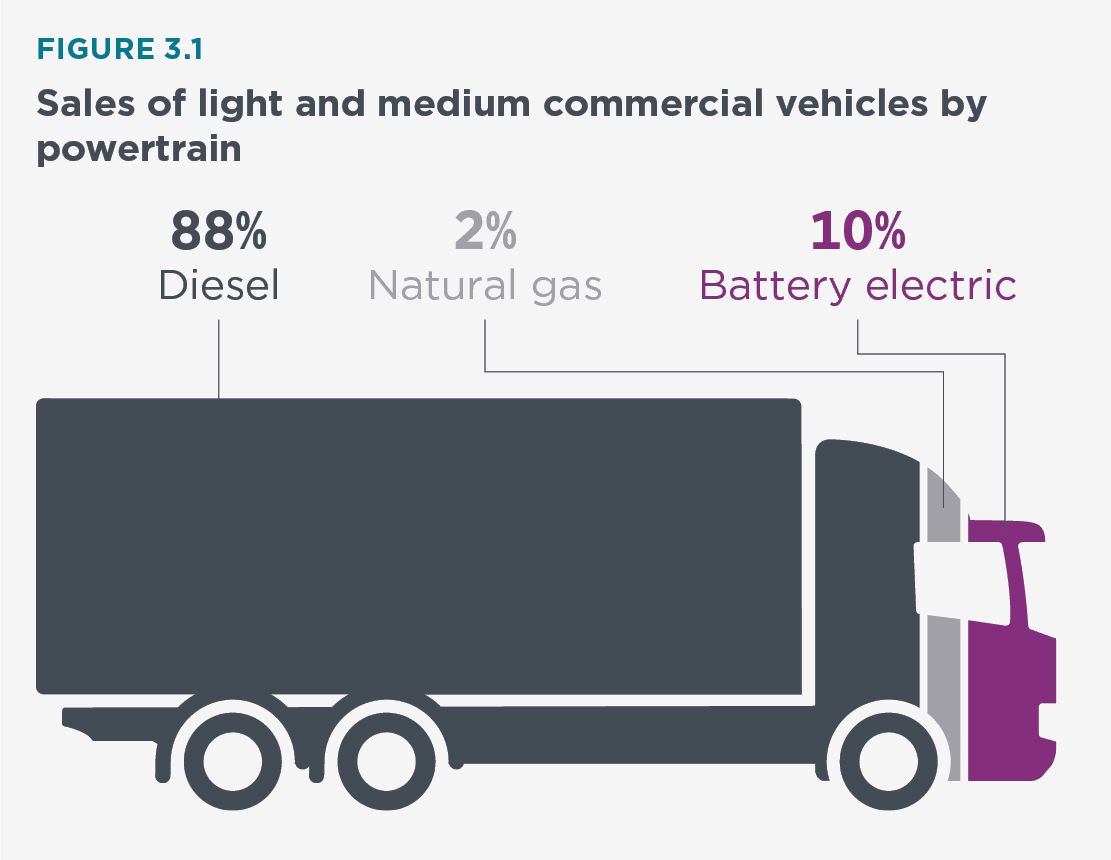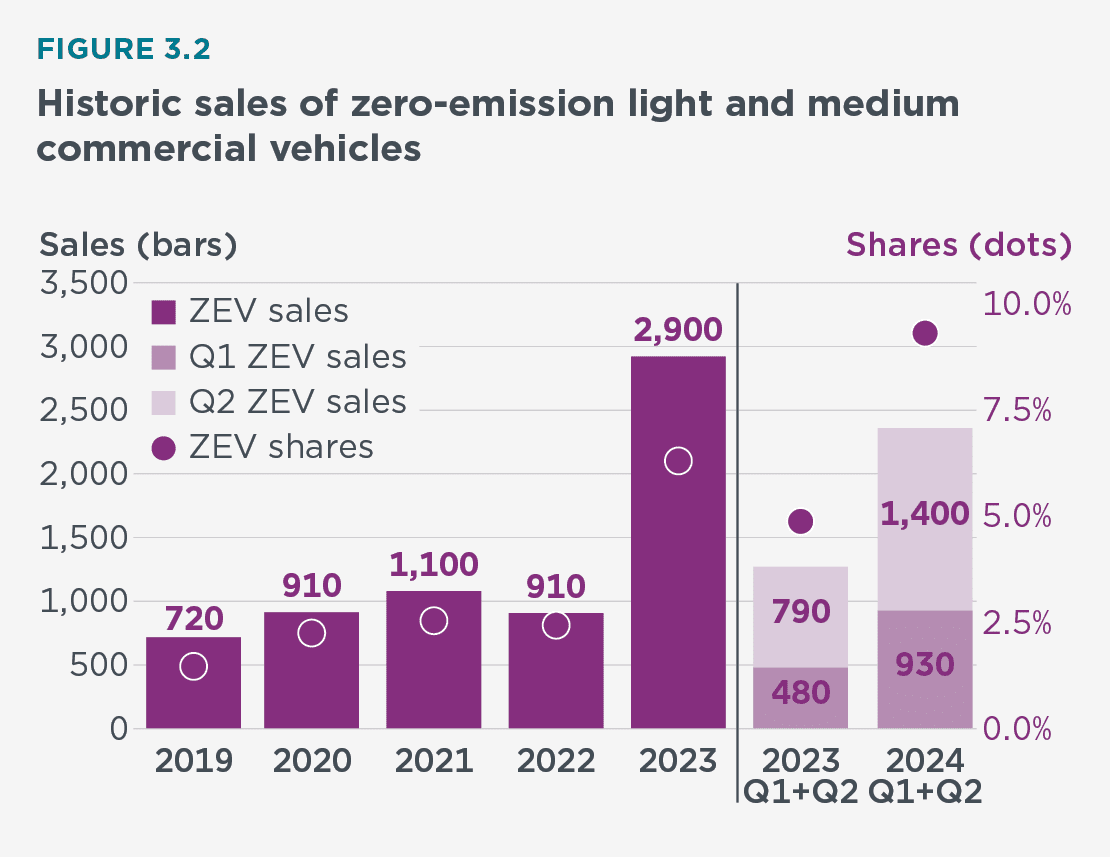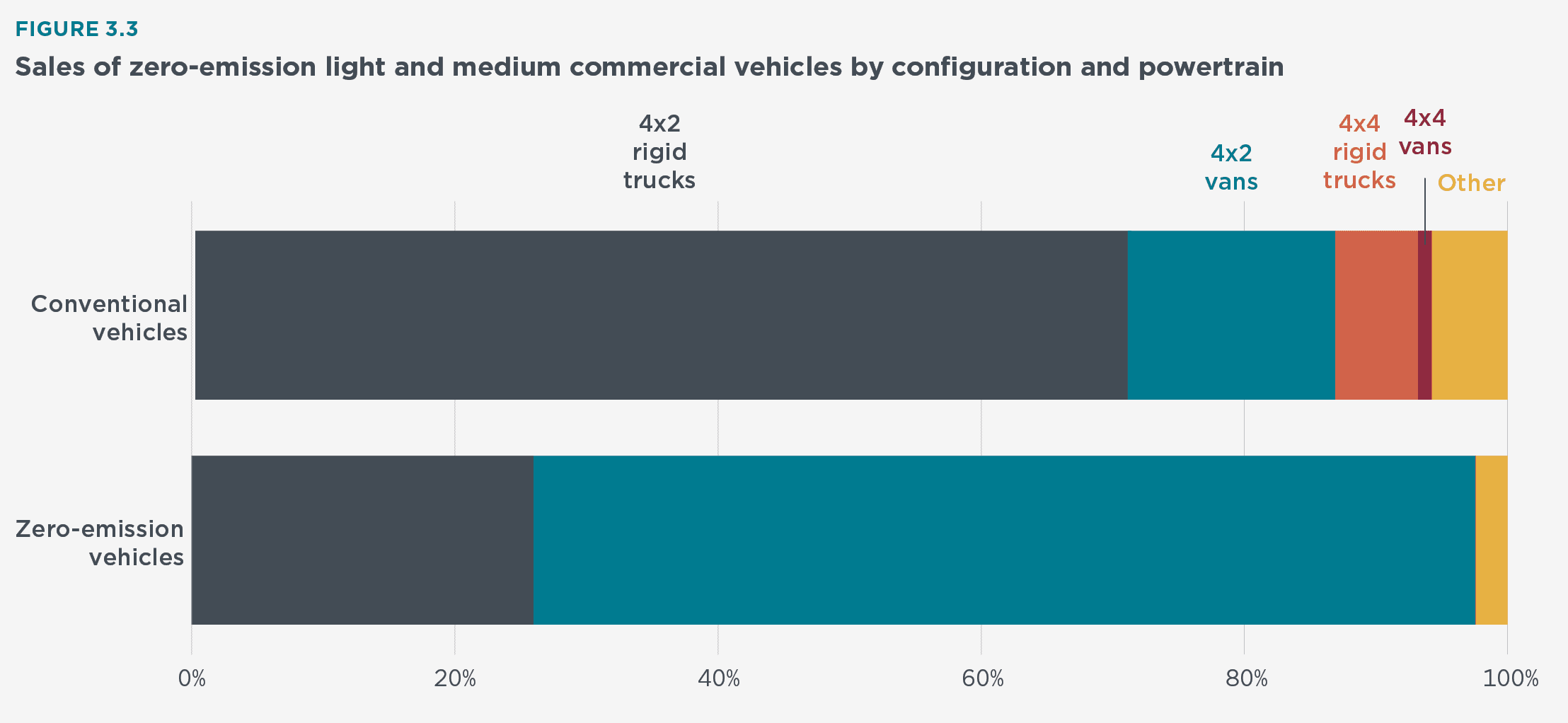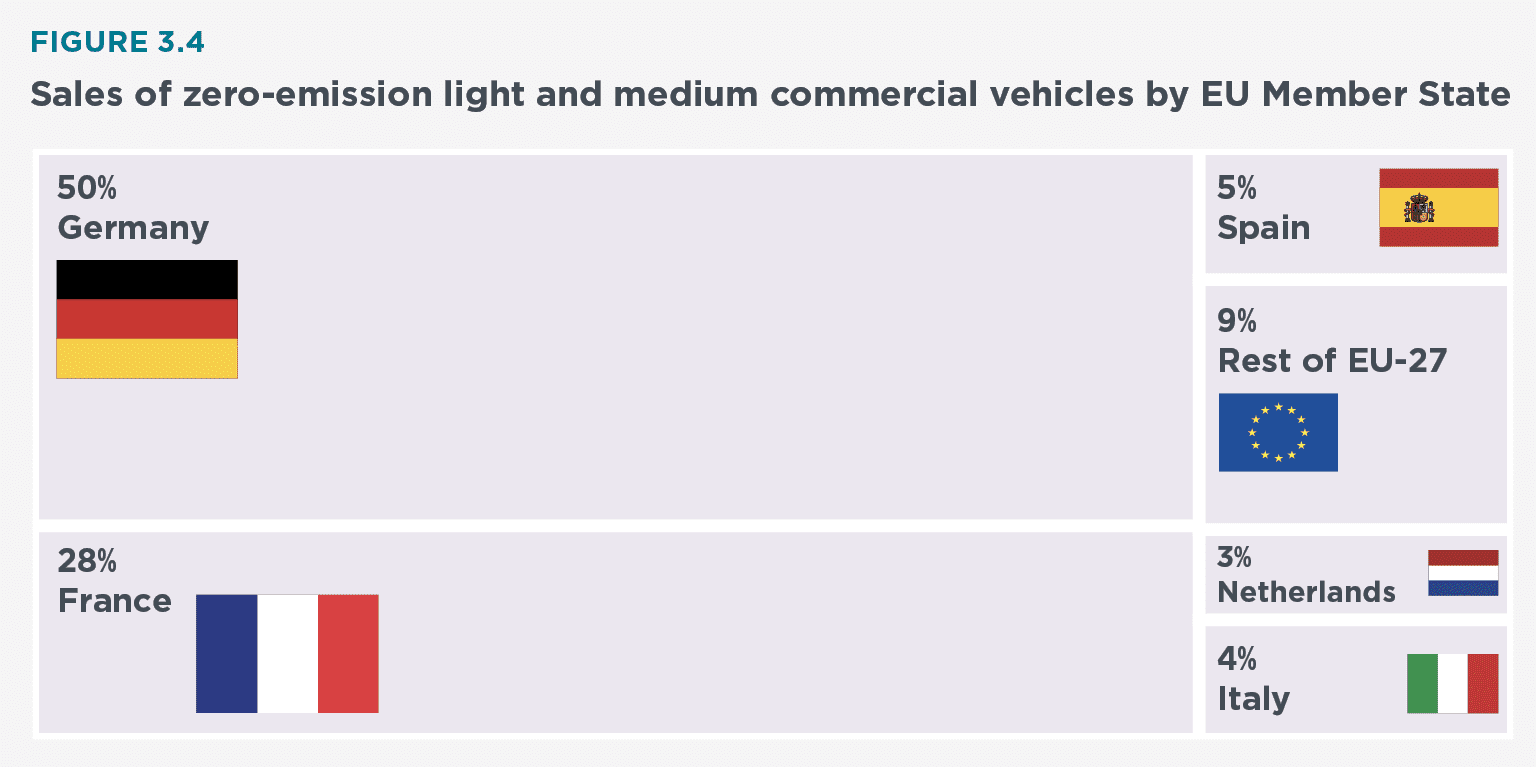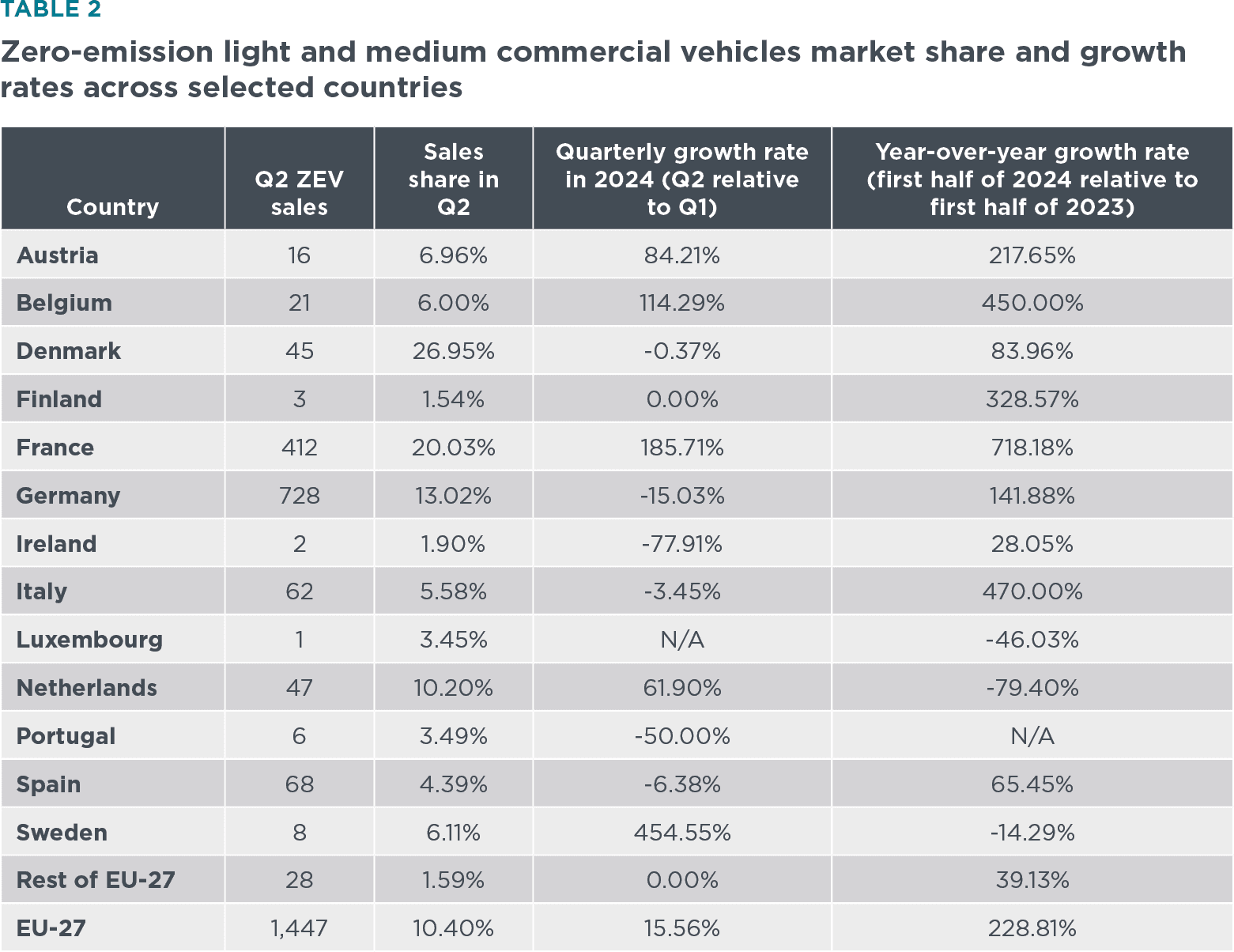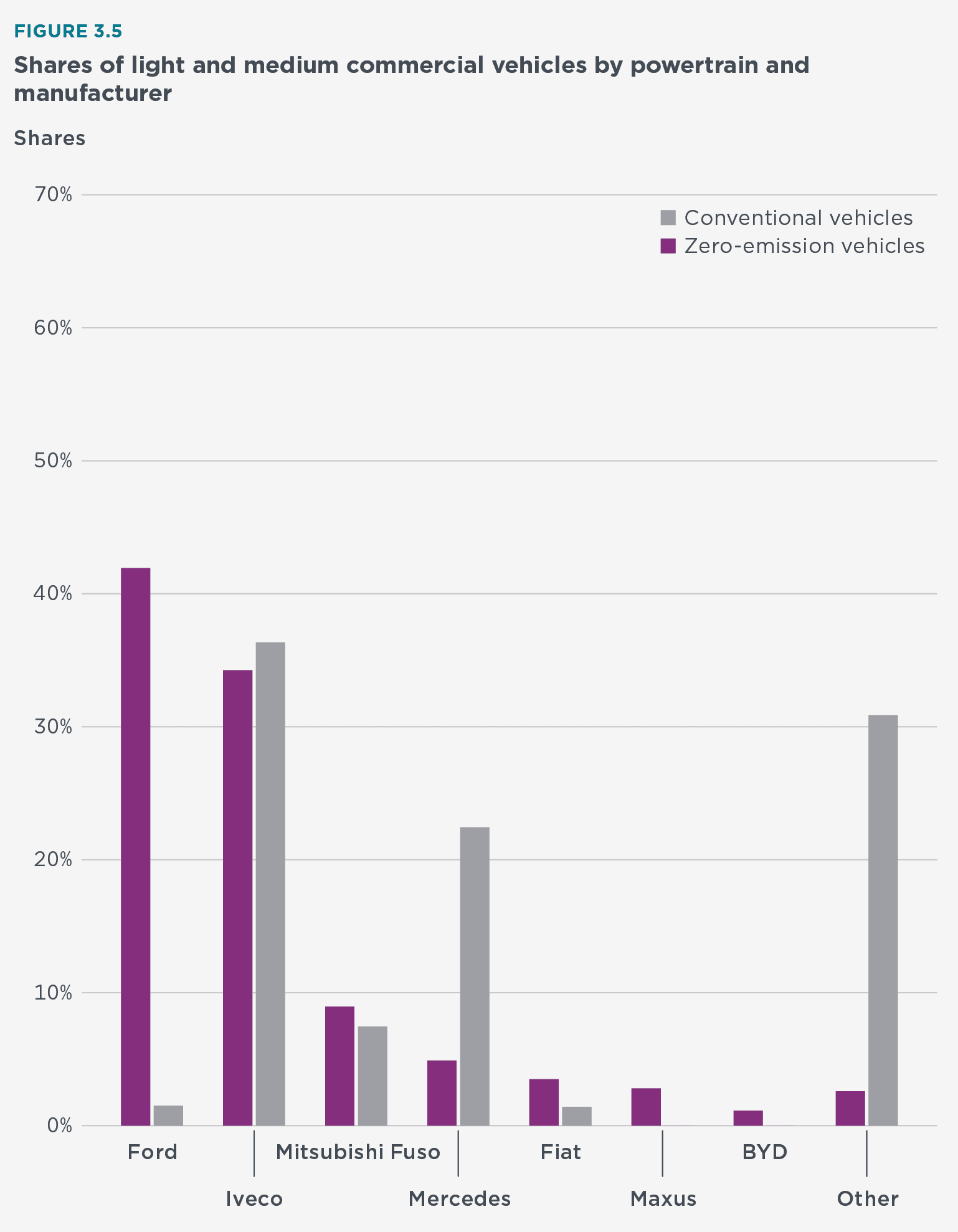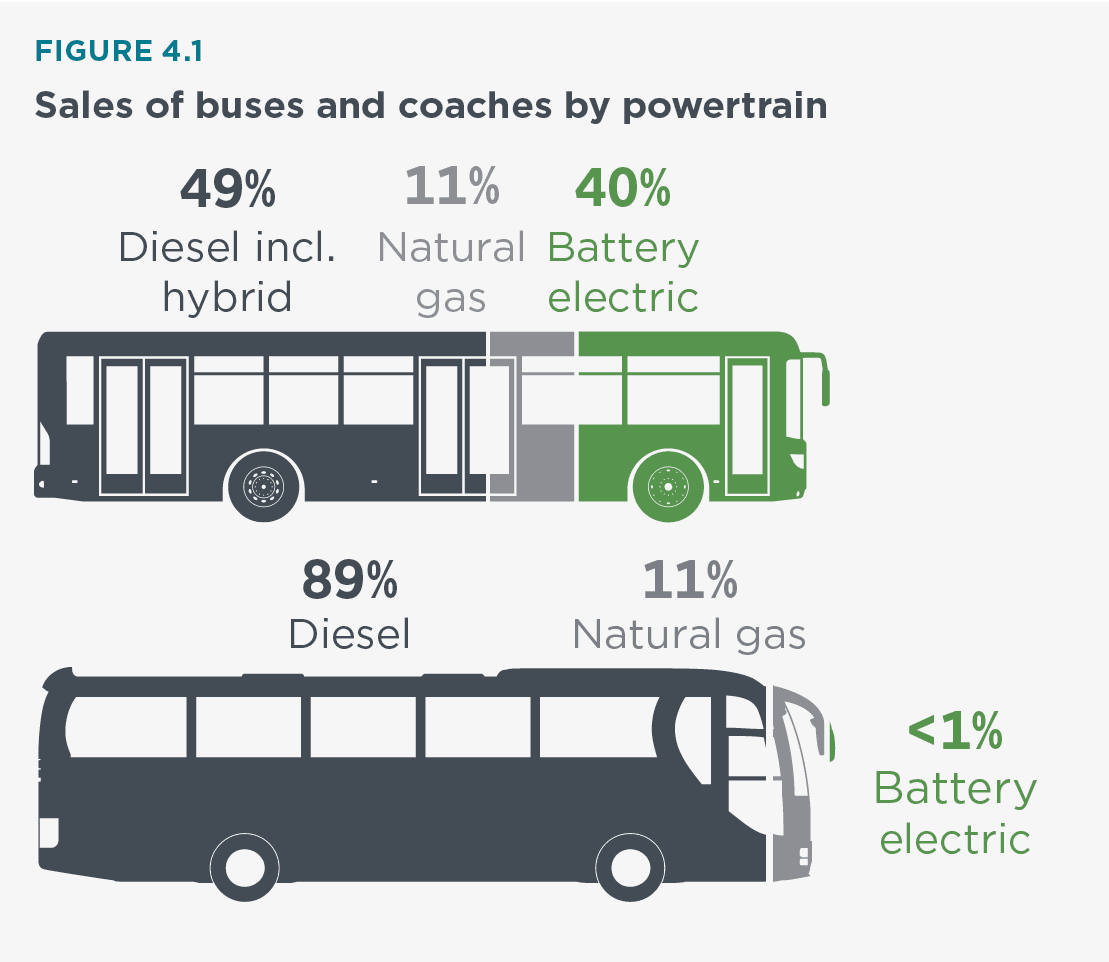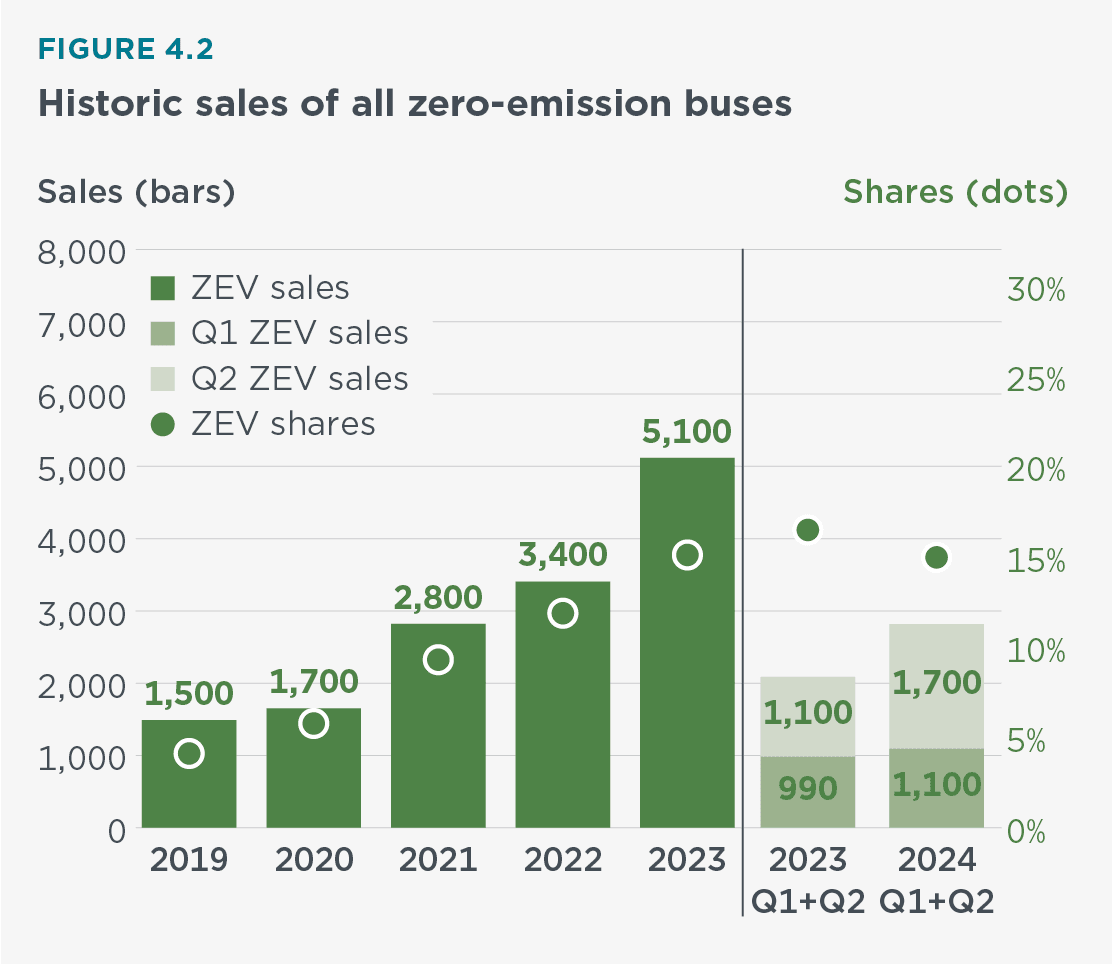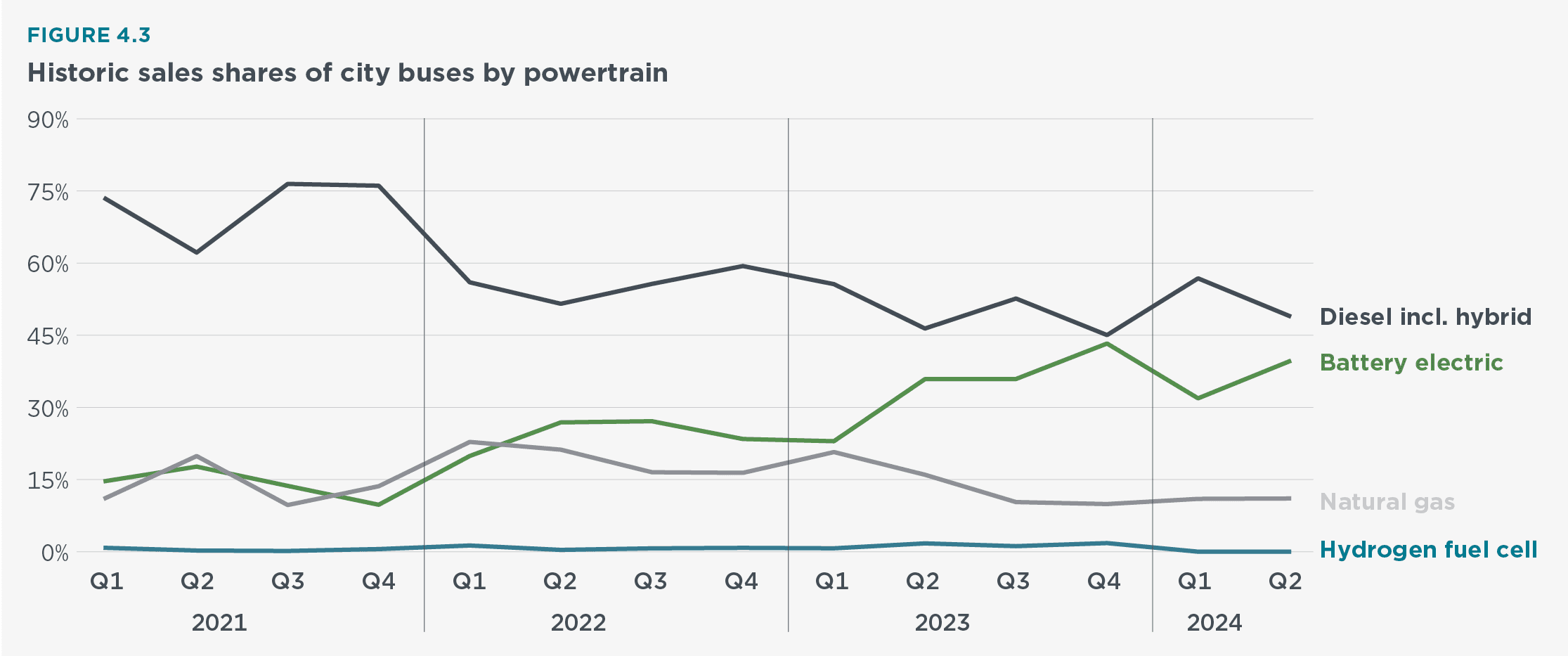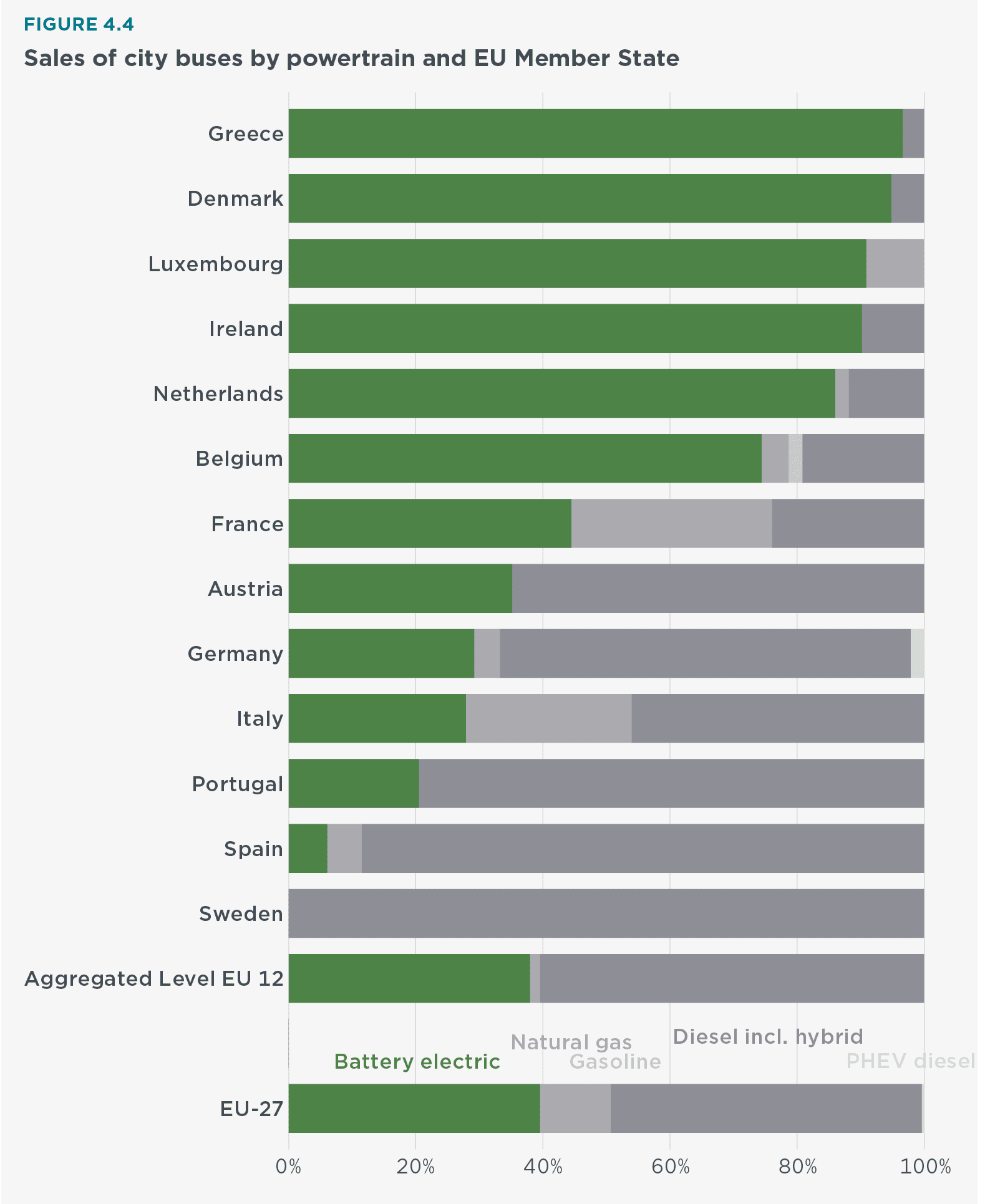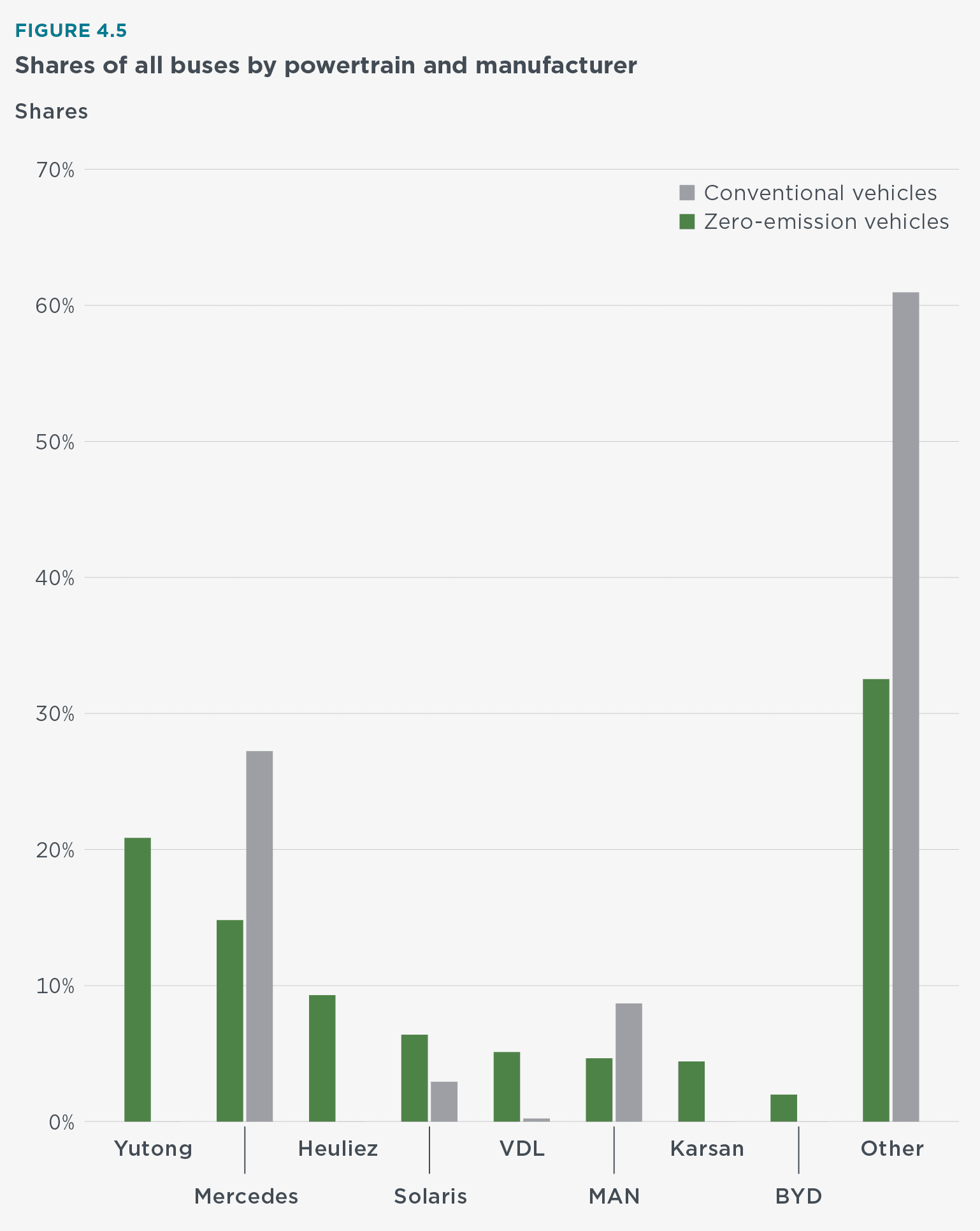Race to Zero: European Heavy Duty Vehicle Market Development Quarterly (January – March 2024)
Market Spotlight
Race to Zero: European Heavy Duty Vehicle Market Development Quarterly (January – June 2024)
Summary
In the second quarter of 2024, the market for heavy-duty vehicles (HDVs) in the European Union grew by 12% relative to the first quarter. Zero-emission vehicles (ZEVs) were for 4.1% of all HDV sales in the second quarter compared with 3.2% in the first quarter. This increase was across all three HDV segments—heavy trucks, light and medium commercial vehicles, and buses and coaches. Germany continued to lead in zero-emission HDV sales in the European Union, accounting for 32.2% (1,282 units) of the total across all vehicle categories in the second quarter.
Zero-emission HDV sales in the first half of 2024 increased by 54% relative to the first half of 2023. The sales share of zero-emission heavy trucks increased from 0.7% in the first half of 2023 (1,076 ZEVs out of 151,327 total heavy trucks) to 1.2% in the first half of 2024 (1,651 ZEVs out of 141,101). The sales share of zero-emission light and medium commercial vehicles rose from 4.9% in the first half of 2023 to 9.3% in the first half of 2024, and sales of zero-emission buses and coaches increased from 2,088 units to 2,819 units. However, the overall market share of zero-emission buses and coaches declined from 16% in the first half of 2023 to 15% in the first half of 2024.
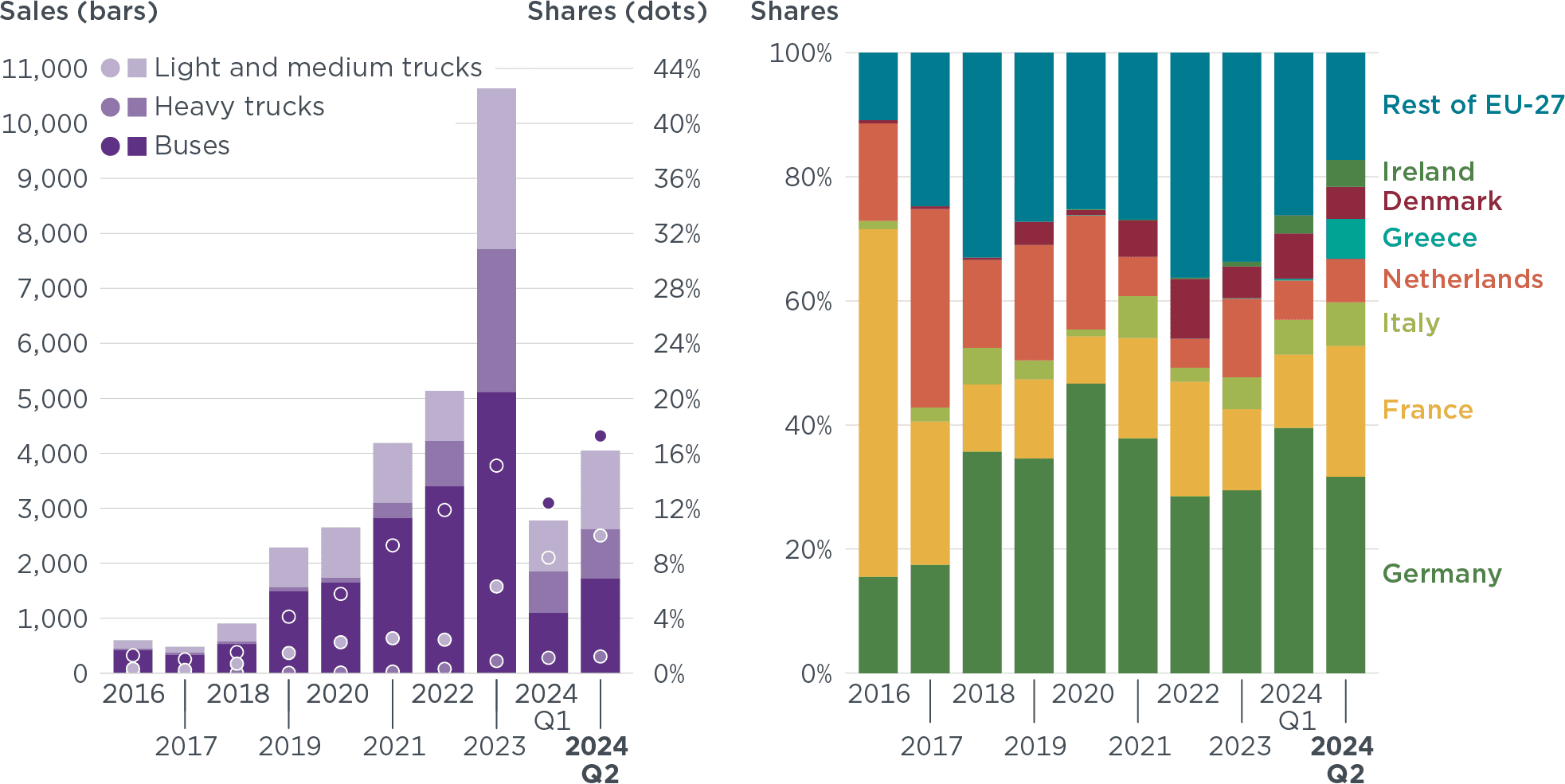
Overall market developments
The seven top-selling HDV brands in the European Union represented 84% of all sales in the second quarter of 2024. Mercedes-Benz was the top-selling brand (21%), followed by MAN (13.8%), IVECO (13.5%), Scania (12.5%), Volvo (11.7%), DAF (9.7%), and Renault (7.1%)
There were differences in the sales mix of the seven top-selling brands in Europe regarding vehicle segments. Heavy trucks represented more than 95% of sales for Scania, DAF, Volvo Trucks, and Renault Trucks. IVECO, meanwhile, sold proportionally fewer of those trucks (47%) and sold more light and medium commercial vehicles (36%), and buses and coaches (17%).
Heavy trucks
Trucks with a gross vehicle weight above 12 tonnes
In the second quarter of 2024, heavy trucks accounted for 75.2% of all HDV sales. Out of 74,000 heavy trucks sold, 916 (1.2%) were ZEVs. This is an increase of nearly 20% compared with the first quarter of 2024 when 755 ZEVs were registered, representing 1.1% of the total market share.
Compared with the first two quarters of 2023, zero-emission heavy truck sales recorded a significant 53% increase in the first two quarters of 2024, with 1,651 units, or 1.2% of total heavy truck sales registered, up from 1,076 vehicles (0.71%) in the first half of 2023.
Volvo Trucks maintained its leading position in the zero-emission heavy truck market in the second quarter with a 43.5% share, driven by the sale of 104 units of the 4×2 FM model and 91 units of the 4×2 FH model. Renault followed with a 17.3% market share, and Mercedes-Benz captured a 14.8% share.
Germany continued to lead in sales of zero-emission heavy trucks in the second quarter of 2024, holding 37% of the market with 335 units sold. France and the Netherlands represented 16% and 17% of the market, respectively. This reflects a minor change relative to the first quarter when Germany held a 41% market share and France held 13%.
🔍 Click on the figures to take a closer look at the data
Light and medium commercial vehicles
With a gross vehicle weight between 3.5 tonnes and 12 tonnes
In the second quarter of 2024, light and medium commercial vehicles represented 14.6% of all HDV sales. Of the 14,292 light and medium commercial vehicles sold, 1,447 were ZEVs, 10% of the segment’s sales. This was a significant increase over the first quarter, when 928, or 8.4% of the trucks sold, were zero-emission. The total number of light and medium trucks sold increased by 29.5% from the first to the second quarter of 2024; the number of ZEVs sold grew by more than 50% in the same period.
Comparing the first halves of 2024 and 2023, light and medium commercial vehicle sales decreased by 2.7%. In contrast, sales of ZEVs in this segment increased by approximately 86%, from 1,270 trucks in the first half of 2023 to nearly 2,400 trucks in the first half of 2024.
Ford continued to lead the zero-emission light and medium commercial vehicle market in the second quarter of 2024 with 41.5% of sales; this is despite representing only 1.5% of internal combustion engine (ICE) truck sales, and sales were primarily driven by the 4×2 axle Ford Transit. IVECO followed closely with more than one-third of all ZEV sales in this segment, mostly driven by its 4×2 axle Iveco Daily; 475 were sold this quarter. Although vans continue to dominate ZEV sales in this segment, making up over 71% of the total, the share of rigid truck sales increased to nearly 26% in the second quarter of 2024, up from 19% in the first quarter of 2024.
🔍 Click on the figures to take a closer look at the data
Buses and coaches
With a gross vehicle weight above 3.5 tonnes
Buses and interurban coaches represented 10.2% of all HDV sales in the second quarter of 2024. Of the 9,976 buses sold, 1,722 were ZEVs, 17.2% of total sales. This is up from the first quarter when ZEV buses were 12.4% of sales. Battery electric city buses accounted for 40% of city bus sales, with 1,616 registered units in the second quarter of 2024. This is a considerable increase relative to the first quarter, when 32% of city bus registrations were battery electric (1,100 units).
Bus sales in the first half of 2024 increased by 48.7% compared with the first half of 2023. Although the number of zero-emission buses sold during the first half of 2024 rose by 35% compared with the first half of 2023, the ZEV share of total bus sales declined from 16.5% in 2023 to 15.0% in 2024.
Manufacturers Yutong and Mercedes-Benz led in zero-emission bus sales, with shares of 20.8% and 14.8%, respectively. Mercedes-Benz also leads the ICE bus market, holding a 27.2% share.
City buses have historically led in adoption of ZEVs in the HDV segment. Although the trend observed in 2023 of several countries selling only zero-emission buses and coaches did not carry over to 2024, sales of zero-emission city buses remain high. The percentage of battery electric city bus sales reached 97% in Greece (261 units), 95% in Denmark (111 units), over 90% in Ireland (166 units) and Luxembourg (40 units), and 87% in the Netherlands (80 units). France recorded an all-time high 45% sales share of zero-emission city buses, with 285 units registered in the second quarter of 2024, the highest number of registrations in the European Union.
🔍 Click on the figures to take a closer look at the data
Technology focus: Development of hydrogen combustion trucks
Looking beyond quarterly sales
Hydrogen combustion trucks burn hydrogen fuel in an ICE that is similar to the engines used for natural gas. The technology can significantly reduce tailpipe CO2 emissions, but its effect on pollutant emissions such as nitrogen oxides and particulates is still being investigated. As highlighted below, several European truck and engine manufacturers have shown interest in developing hydrogen ICE vehicles.
Europe
Engine manufacturer Cummins stated in late 2022 that its hydrogen ICE for medium trucks is suitable for applications with gross vehicle weights between 10 and 26 tonnes. Cummins also announced a 15-liter 500 HP hydrogen ICE for long-distance applications, suitable for HDV applications.
DAF has developed a prototype hydrogen ICE version of its XF rigid 26 tonnes GVW truck, based on a Paccar MX13 12.9-liter engine with common rail.
MAN announced a zero-emission roadmap in late 2020 that included the testing of hydrogen ICEs alongside fuel-cell and battery electric trucks. More recently, MAN publicly mentioned that a prototype truck running on a 16.8-liter hydrogen engine has been under testing since 2021. In April 2024, MAN announced that it would begin small series production of hTGX, a hydrogen model of the MAN diesel TGX truck, and it plans to offer 200 units in 2025.
Volvo became a member of the Hydrogen Combustion Engine Trucks consortium, an initiative funded by the German government, in 2022. Volvo recently confirmed that it plans to include hydrogen ICEs in its future production mix and expand its research activities in this regard.
While IVECO has not yet announced any pilot projects for hydrogen ICE trucks, it announced that it is involved in developing hydrogen engines for trucks through its FPT Industrial powertrain brand.
Scania is part of a joint demonstration program with Westport to demonstrate high-pressure direct injection (HPDI) hydrogen ICEs for highway trucks. The engine was tested in 2023. In 2024, Westport and Scania presented the test results at the Vienna Motor Symposium, showcasing a 51.5% brake thermal efficiency and engine-out nitrogen oxides emissions similar to a diesel engine.
KEYOU, a German startup specializing in developing and implementing hydrogen ICEs for HDVs since 2015, introduced an 18-tonne hydrogen ICE truck based on the Mercedes Actros chassis in September 2023. Regensburg-based freight forwarder EP-Trans is currently testing this truck.
Daimler Trucks announced in October 2023 that hydrogen combustion could be a viable CO2-free pathway, mainly for vocational vehicles, and began testing a multi-purpose Unimog truck equipped with a hydrogen ICE. In late July 2024, Daimler concluded that the technology is viable for such applications and ready for commercialization.
Between 2021 and 2023, Renault Trucks was a member of a consortium of national labs, energy providers, and vehicle manufacturers to demonstrate a hydrogen ICE for medium- and heavy-duty trucks. trucks. The consortium was led by the Université d’Orléans and financed by the French government.
Other markets
European truck manufacturers are also showing interest in hydrogen ICE technology in other markets, mainly in North America.
Daimler Trucks North America presented its 15-liter 335-kW hydrogen ICE demonstration engine at the 21st Century Truck Partnership. The company also showcased its testing results of the demonstration engine at a California Air Resources Board workshop on the Role of Hydrogen in California’s Medium- and Heavy-Duty Vehicle Fleet.
In November 2022, the Southwest Research Institute launched a joint project to develop a Class 8 hydrogen ice truck. The joint venture includes several European manufacturers, including Cummins, Bosch, and Daimler Trucks North America. Demonstration of the vehicle is planned throughout 2024.
In July 2024, Volvo and Westport Fuel Systems launched a joint venture in Canada to accelerate the development of Westport’s high-pressure direct injection technology. Volvo intends to deploy this technology in hydrogen ICEs.
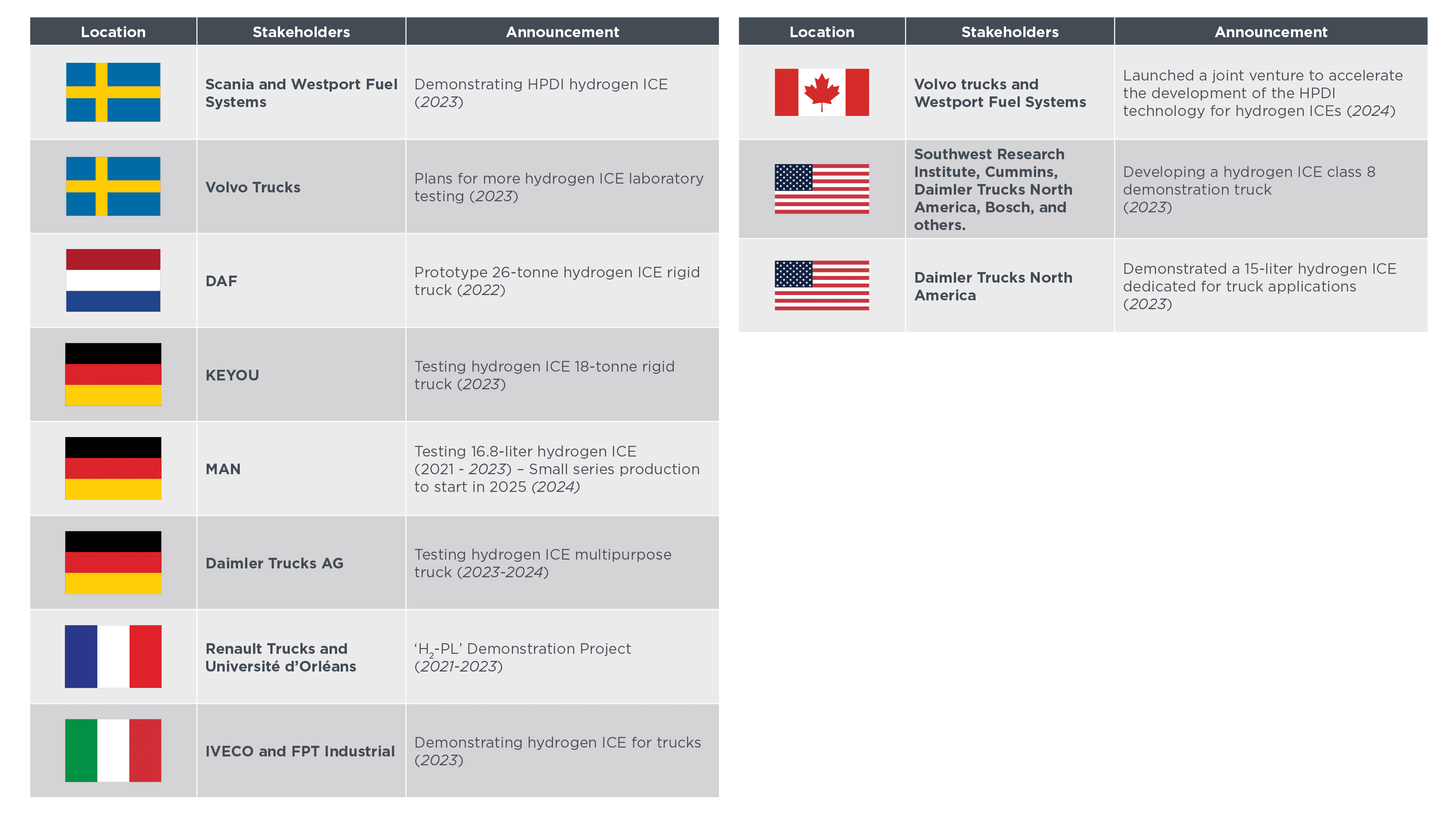
Definitions, data sources, methodology, and assumptions
A zero-emission vehicle is any vehicle whose propulsion system produces zero combustion emissions, such as a dedicated battery electric, fuel-cell electric, or other motor that is not driven by combustion.
A heavy-duty vehicle is a commercial vehicle, intended for the transport of passengers or freight, with a gross vehicle weight above 3.5 tonnes.
A heavy truck is a truck with a gross vehicle weight above 12 tonnes.
A light and medium commercial vehicle is a truck or van with a gross vehicle weight between 3.5 and 12 tonnes.
A city bus is a passenger vehicle with a gross vehicle weight above 3.5 tonnes that is used exclusively in urban environments.
An interurban bus is a passenger vehicle with a gross vehicle weight above 3.5 tonnes that is used in both urban and regional environments.
A coach is a passenger vehicle with a gross vehicle weight above 3.5 tonnes that is used exclusively in regional environments.
All data are supplied by Dataforce. All countries from the EU-27, except Bulgaria, are covered here. Data for Spain are sourced from the European Automobile Manufacturers’ Association (ACEA).
All information presented in the technology spotlight section are based on public announcements and press releases made by truck and original equipment manufacturers, taken directly from their websites.
